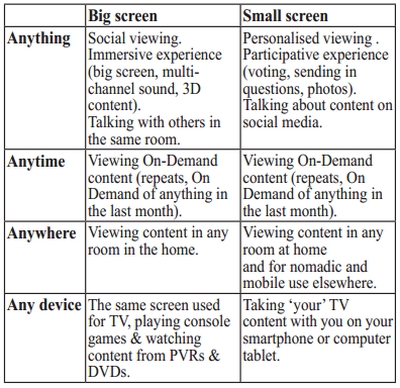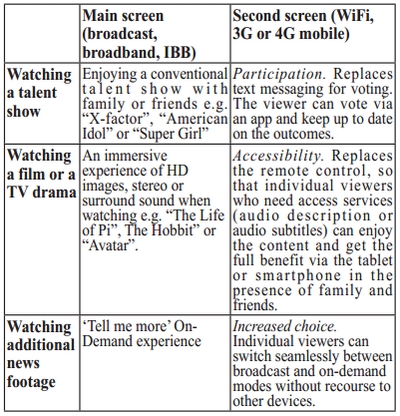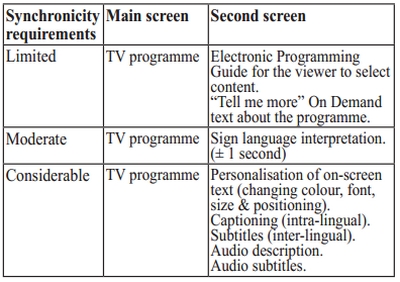



Many observers have written off TV as a 20th century medium with little relevance in this one.
TV in the 20th century - a Social Experience
Following its appearance in 1928, viewing television programmes was initially a social experience. For the first few decades, the TV television set itself was relatively expensive, and TV viewing was therefore a collective activity. The television signal was initially delivered to TV screens by terrestrial broadcasting.
Towards the end of the 20th century, TV sets became cheaper and terrestrial broadcasting was joined by distribution over cable, satellite networks using the Internet protocol. The number of available channels increased with the emergence of Pay-TV. The remote control became an important prerequisite of viewing. With more channels to choose from, the viewer could change channel without going over to the TV set to change channel. Middle-class homes had two or more TV sets. Being able to watch TV content on small handle-held devices moved into the mainstream. The emergence of devices like iPods and streaming music services in the noughties also changed consumer attitudes to TV and Video On-Demand.
TV in the 21st century - Convenience
In the 21st century the trend towards multiple screens – big stationary ones in the home and smaller, portable ones elsewhere - has become more accentuated. The mantra for TV content is now convenience - ‘anything, anytime, anywhere and on any device’. Take the case of TV in Hong Kong. There are still TV sets and remote controls in most homes with free-to-air TV from 2 main networks TVB and ATV, Cable TV and PCCW’s now TV delivered using Internet protocols. But viewing patterns are now more diverse. A recent study by TNS suggests that in Hong Kong the average citizen has nearly 2 mobiles (conventional phones, smartphones and tablets). Young adults have never watched much TV. Today are more likely to view TV-like content such as Psy’s Gangnam Style on YouTube while on the move than
to see TV at home as many young adults do not have a TV set, preferring to use their laptops or tablets. Exceptions include major events such the Olympic Games or a blockbuster TV drama series where viewing is still a social phenomenon. With so much TV-like content on offer, is TV on a big screen at home really dead or soon to become obsolete?
Figure 1 summarises they key similarities of big and small screens:
The figure shows that the move from one stationary screen in the home to multiple stationary and mobile screens has lead to a differentiation of viewer behaviours.
With the emergence of streaming services via wireless Internet to laptops, smartphones and tablets, studies in industrialised countries have identified the ‘second screen’ phenomenon. Early examples of what the second screen offers are summarised in Figure 2:
Figure 2 gives indications that a well-designed two-screen solution enhances the quality of the TV experience by focusing on convenience and ease of use.
It is worth noting that each screen uses its own network. The main screen may use digital broadcast, IPTV or some kind of integrated broadcast-broadband (IBB) system such as HbbTV or HybridCast. The second screen usually uses a WiFi or a 3G/4G mobile network connection.
Broadcast television is a ‘push’ service that delivers content with a small, fixed delay to the device. Content such as video, audio or subtitles delivered over the Internet are, however, ‘pull’ services.
The delay in delivering TV content will depend on the quality and bandwidth of the connection – and the delay itself may vary. Figure 3 gives examples of the synchronicity requirements for different kinds of TV content:
In the first example, the EPG is not sensitive to lack of synchronicity between the two screens of less than, say, 10 seconds.
In the second example (offering a sign language overlay for persons who were born deaf and whose mother tongue is a sign language), the second screen needs to be reasonably in sync with the main screen. Research studies indicate that as long as the sign language interpretation is within a second, this is still acceptable to users of such a service.
In the third cluster of examples, offering such features without a synchronisation mechanism is potentially a risky business as the acceptability threshold may be as little as 100 – 150 milliseconds (lip sync). Fortunately, standardisation efforts are already underway around the globe to provide robust synchronisation mechanisms for content delivery both one one-screen and two-screen hybrid platforms such as HbbTV 1.2 and HybridCast.
One screen or two – the implications
For those wanting to watch television content, the second screen enhances the viewing experience. Some of the services can already be offered with devices on the market. Others will require a few more years until buffering and synchronisation are no longer an issue.
In the media industry, those who stand to gain are free-to-air channels and networks available on (digital) terrestrial broadcasting systems. As IBB TV sets become the norm, these organisations will be able to take up the challenge from Pay-TV and IPTV operators that already have the potential to offer many of these enhancements.
By the same token, Pay TV operators will have to address the challenge of ‘over the top’ services from broadcasters or other delivered to ‘their’ customers: brand and market-share erosion.
For regulators concerned with TV quality, second-screen entertainment formats targeting young demographics will be increasingly difficult to monitor and regulate. It’s one thing to monitor the traffic of text messages, and a very different challenge to monitor wireless Internet traffic.
For TV to retain its relevance as an audiovisual medium in the 21st century, television viewers will expect TV content to continue to match their needs and expectations. So it will not be an issue of one TV screen or two, but when a single screen or a second screen can best enhance the viewing experience.
* Currently chairs the ITU “Focus Group” on Audiovisual Media Accessibility, a global group that has a mandate to prepare a roadmap of accessibility actions to do with standardisation, legislation and regulation for submission to the ITU by mid 2013.


